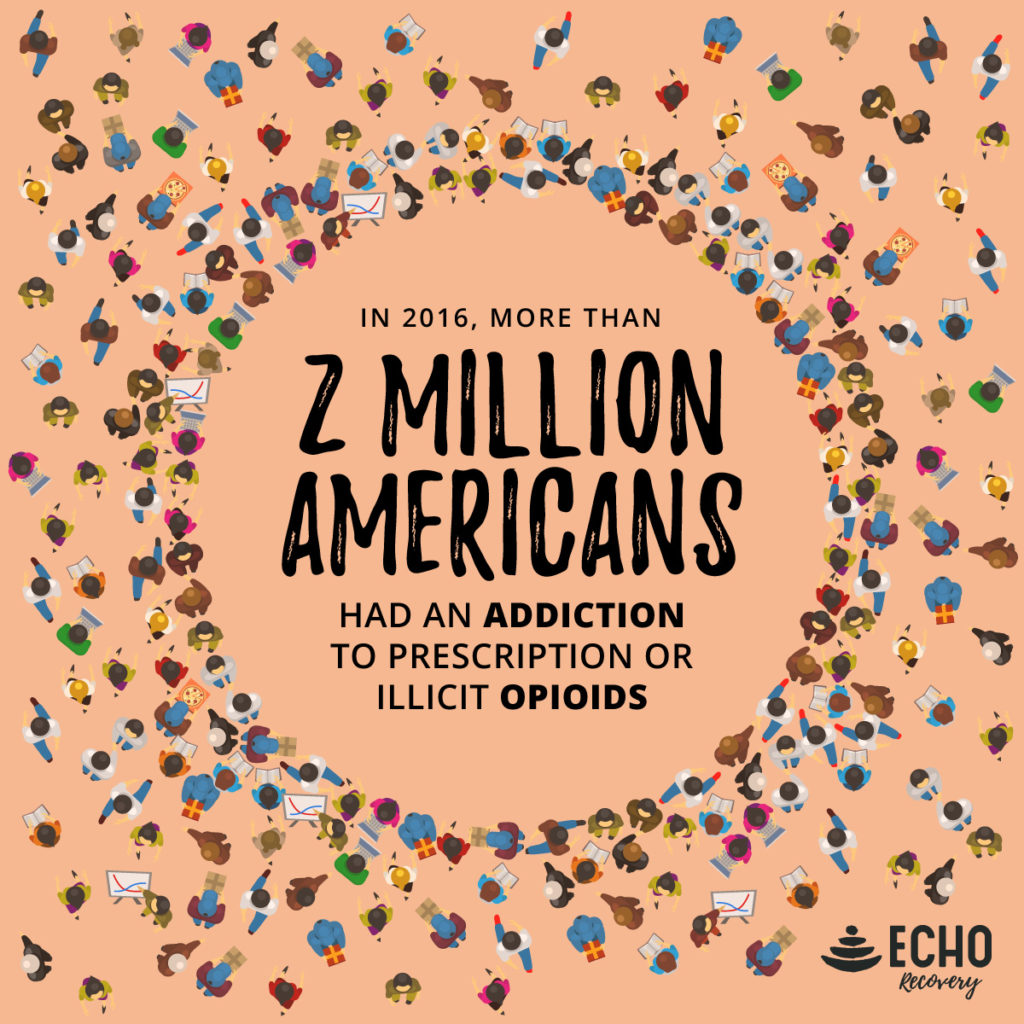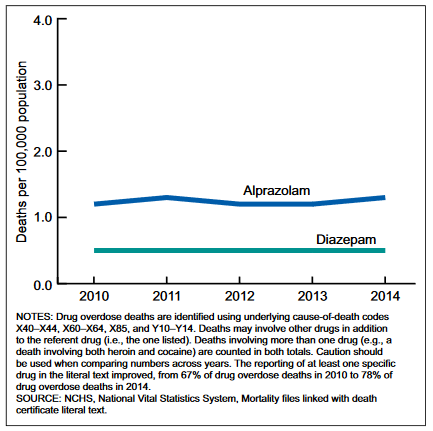Opioids are the drug at the root of the current overdoses and addiction crisis in the United States, and benzodiazepines are the drug at the heart of a silent epidemic that is happening at the same time, but hasn’t garnered as much attention in the media.
The results of a study on “Increasing Benzodiazepine Prescriptions and Overdose Mortality in the United States, 1996–2013” found that the percentage of American adults filling benzodiazepine prescriptions had increased from 4.1% to 5.6% in the 17 years between 1996 and 2013. Shockingly, revised numbers by the National Institute on Drug Abuse as of 2018 put that increase at 67%. Representing an increase of 8.1 million to 13 million.
With the number of people addicted to drugs alike Xanax, Valium, and Klonopin increasing, and subsequent benzodiazepine overdose and addiction treatment admissions skyrocketing, the case for a possible benzodiazepine epidemic in America must be made.
The Benzodiazepine Epidemic in the United States
The number of opioid prescriptions being filled in the United States has decreased since 2016 – a sign that prevention measures put in place in-response to the opioid epidemic are working. While we haven’t seen the trickle down effects of opioid epidemic responses lowering the number of overdose deaths, we are seeing early wins.
If low prescription rates for opioids signal a positive trends in the opioid epidemic, increased benzodiazepine prescription rates signal a negative and dangerous trend that appears to be getting worse every year.

Benzodiazepines Overdose Statistics:
Benzodiazepines were involved in 30% of all prescription drug deaths in the year 2013 – a number that would shock the medical community, and spur a response from the public, if it wasn’t being overshadowed by and even bigger number. 70% of all prescription drug deaths involved opioids.
“75% of benzodiazepine deaths in the US also involve opioid use”
The overdose rate for benzodiazepines alone quadrupled from 1999 to 2010 in Adults 18-64 years in age.
Key Statistics on Benzodiazepine Addiction:
- Benzodiazepine overdoses increased from 1,135 (1999) to 8,791 (2015) in 16 years.
- The increase in benzo overdoses between 1999 and 2015 was more than 700%.
- Alprazolam (Xanax) was involved in 3,677 deaths in 2010.
- Alprazolam (Xanax) was involved in 4,043 deaths in 2011.
- Alprazolam (Xanax) was involved in 3,785 deaths in 2012.
- Alprazolam (Xanax) was involved in 3,696 deaths in 2013.
- Alprazolam (Xanax) was involved in 4,217 deaths in 2014.
- Alprazolam (Xanax) is consistently involved in more deaths than Diazepam (Valium).
- The percentage of people using benzodiazepines increases directly with the age group (the older the age group, the higher percentage of benzodiazepine use).
- Emergency room visits involving mixed opioids and benzodiazepines increased from 11 (per 100,000) to 34.2 between 2004 and 2011.
- Increases in benzodiazepine overdose deaths between 2004 and 2011 hit every age group except the 12-17 year old age group.
Maryland Benzodiazepine Overdose Statistics:
- Emergency room visits involving mixed opioids and benzodiazepines increased every year in all demographic groups in Maryland since 2007.
- Overdoses involving benzodiazepines and opioids make up 53% of overdose cases in Maryland.
- Overdoses involving benzodiazepines and fentanyl make up 45% of overdose cases in Maryland.
- Overdoses involving benzodiazepines and heroin make up 43% of overdose cases in Maryland.
- The total amount of overdose deaths in Maryland has increased every year, from 649 deaths in 2010 to 20189 deaths in 2016.
Why is Benzodiazepine Use, Abuse, Addiction, and Overdoses Increasing?
There have been a lot of theories as to why benzo use is increasing in popularity in recent years. However, to understand why more people are using and becoming addicted to benzodiazepines, you really only need to look at what benzodiazepines are prescribed to treat, and the uses of benzodiazepine.

What are Benzodiazepines Used For?
Benzodiazepines are primarily used to treat anxiety, sleeplessness, seizures, and pain and discomfort caused by a number of medical issues. They are also used in treating addiction to alcohol, opioids, and even addiction to benzodiazepines. Further, benzodiazepines are often used in conjunction with antidepressants to treat depressive disorders, bipolar disorders, and a host of other mental health issues.
When we put together all of the issues that benzodiazepines treat, we come up with a list:
- Anxiety and Panic Disorders
- Depression
- Drug and Alcohol Addiction
- Insomnia
- Personality Disorders
We have a mental health crisis in America and across the world that we are not dealing with adequately – just medicating its symptoms.
Why Has the Prevalence of Mental Health Disorders Increased in Recent Years
There are innumerable reasons why mental health disorders have increased since the year 2000 – the whole world has been under a lot of stress. From the September 2001 terrorist attacks and following wars in both Iraq and Afghanistan, the world changed rapidly in the past nearly 2 decades. Add to that a housing and financial crisis, technological advances bring technology deeper into your life and threaten your privacy, and – of course – social media.
In short, the past 20 years have taken a toll on humanity and most assuredly can be to blame for the increase of mental health illnesses in those without a genetic predisposition to mental health illnesses. We are a world of people that are self-medicating the very real pain and injury we feel from a world moving faster and becoming more chaotic and aggressive in nature.
It is believed that the opioid epidemic was the first wave of a response to changes in society and in our world. While we are making strives to address the opioid epidemic now, we must not forget that a second wave is following closely behind the opioid epidemic, in the form of a benzodiazepine epidemic.
Preventing a Worsening Benzodiazepine Addiction Epidemic
Inaction in the beginning is what caused the opioid epidemic to become out of control so quickly, and we must not let inaction worsen benzodiazepine addiction rates in the U.S. and cause a benzodiazepine addiction epidemic. We need to cut off the growth of prescription benzodiazepine abuse – just as we have with prescription opioid abuse, and we need to make more addiction treatment and housing options available for those struggling with addiction.
The United States is lacking the treatment capacity to deal with those needing treatment for opioid addiction in the wave of the opioid epidemic. Adequate housing, housing assistance, and transitional living options are in high demand and short supply. We do not have the resources to deal with the current addiction epidemic, and we will be severely hit with a greater lack of resources if a second wave of an addiction epidemic comes in the form of a benzodiazepine epidemic.
Learn more about ECHO Recovery’s efforts to provide affordable drug and alcohol recovery housing in the United States. Our efforts aim to help with opioid epidemic recovery, and to help prevent benzodiazepine addiction from becoming America’s next prescription drug crisis.

Experienced Chief Executive Addiction Recovery and Mental Health Professional
Business professional in the Addiction Recovery and Mental Health industry for the past 26 years. Caring, compassionate and strongly motivated to make a difference in the organizations I am affiliated with and welfare of the population we serve. Currently focused on advocating, educating and developing projects leveraging evidence based, real time technology to support individuals in recovery.




